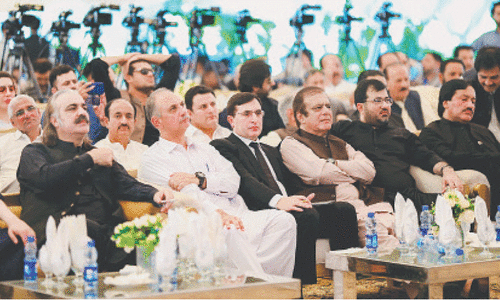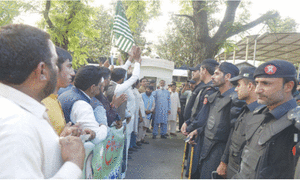Gandhara, the cradle of Buddhist Civilization, gave birth to the famous Gandhara art. Research conducted by foreigners and Pakistani scholars has showed that the purpose of this art was to propagate Buddhism through different images carved and made in stones, stucco, terracotta and bronze.
The main focus of the art was Buddha's life stories and individual images, his previous birth stories (Jatakas) and future Buddhas.
The most important amongst them are the figures of historic Buddha, his miracles and all episodes from his birth to death.
The local artists, stimulated by the personality of Buddha, took advantage of the contacts, motifs and technology from Greeks, Romans and Persians and developed such a unique art which imortalised the Buddha.
The life stories of Buddha depicted in Gandharan Art are an authentic document of the Mahayana text composed during the time of Kushana rulers.
In fact, the sculptors of Gandhara translated the Buddhist Mahayana religious text into details in stones, stucco, terracotta and bronze, making it more romantic and providing a base for the expansion of Buddhism towards the Far East via the Silk Route through pilgrims and traders.
The Gandharan sculptures were fixed to the bases, drums and stairs of the stupas around which the worshippers circumambulated and individual figures filled the niches around the stupas and monasteries.
These stories were chiselled on stone tablets and fixed to the stupas, inside which relics of Buddha were kept in a casket for the purpose of worship.
About the pieces uncovered, senior archeologist A.G. Lone says: “One important characteristic of Gandhara art is its passionate love for art showing the life of Buddha. If we put in order the extremely numerous Gandhara relief of Buddha stories which have been unearthed piecemeal, the number of scenes portrayed actually exceeds a hundred.”
They start with the story of events surrounding the birth of Buddha, the legends of boyhood and youth, the renunciation seeking the truth, then the enlightenment and the first preaching, he says.
Then, they proselytise for the spread of Buddhism in various ways, including stories of miracles. Finally, there are scenes of Parinirvana, placement in the coffin, the burning of the body, disposal of relics and the raising of the stupas.
One of the greatest contributions of Gandhara to the Buddhist art was its focus on the life of the Buddha himself. “Gandhara really offers a ‘carved drama’ of the Buddha's life. Interestingly, the Buddha's image was first personified in Gandhara (during Asoka's reign 273 BC-232 BC).”
The Taxila Museum is a real treasure house of Gandhara civilization and art. There are around 24 stories about Buddha carved in stones which are on display in the museum.
The life stories of Buddha were written in Gandhara and in their light the sculptors carved them in stones. It was Emperor Kanishka who was the patron of Buddhist art and ruled the vast Kushan Empire from his capital Peshawar in 78 AD.
It may be mentioned that Buddhism took a new form in Gandhara during the times of Emperor Kanishka which is known as Mahayana Buddhism. The Gandhara art was called the Graeco Buddhist and Romano Buddhist by the art historians.
The region prospered and Gandhara art flourished as trade and commerce grew with Central Asia and the West via the Silk Route.
There are more than 1,400 stone artifacts in Taxila Museum and reserve collection, half of which have been documented in two volumes by the department of archaeology and museums.
These artifacts have been discovered from different sites of Taxila. Besides the stone sculptures, the artifacts included panels depicting life stories of Lord Buddha, Jatakas, tools, daily-use utensils, relic caskets and architectural elements.
There are three life stories of early 24 Buddhas engraved on stones known as Jatakas of the Great Buddha found during excavations at various sites in the Taxila valley.
These life stories are identified as Dipankara Jatka, Vishvantra Jataka and Syama Jataka.
Besides, stone sculptures are displayed in the museum depicting Siddhartha (Buddha)'s life stories, including “Dream of Queen Maya” which according to the archeologist shows that before the birth of Siddhartha (Buddha) his mother dreamed that a white elephant is penetrating in her womb.
She told this to her husband Sadhudana who called a fortune teller to predict the dream. The fortune teller predicted the birth of Siddhartha. The other stone depicts the story of the “birth and bath of Siddhartha”.
According to the archeologist, this story reveals that when Queen Maya was visiting her parents, she gave birth to Siddhartha in a garden called Lumbani garden. Siddhartha emerged from her ribs.
While the third story carved on the rock is of “archery contest” in which, according to the archeologist, it is showed that Siddhartha (Buddha) prepared for an archery contest and defeated all his rivals. Another picture shows the “marriage of Siddhartha”.
According to the archaeologist, Siddhartha (Buddha) married Yasohdra at Kapilvastu (southern Bhir, Nepal).
The stone carving shows the “palace life of Siddhartha” which according to the archaeologist depicts that Siddhartha lived a very luxurious and comfortable life in his three palaces built for all seasonal requirements. Yet another story is about “the great departure of Siddhartha” which according to the archaeologists shows that at the age of 29 he realised that there was some mystery in his artificial life different from reality. So he left in search of truth.
Another stone shows the “Farewell of Kanthaka”. While Siddhartha (Buddha) was leaving his palace his horse Kanthaka and attendant Chandaka bowed before him and went back to the palace after leaving him in a forest.
There are also other life stories of the Great Buddha including one offering the scene of monkey, taming of a wild elephant, Devadatta's assignation, death of Buddha, cremation, Stupa worship. Archeologists said there are nine non Buddhist deities, including Indra, Brhama, Mara, Panchika and Hariti, Nagas, Guruda, Aphrodite, Atlas and Kuvira.












































